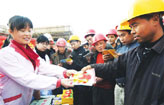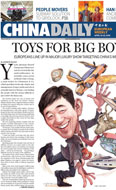Society
Italian finds India a nice place to make cheese
Updated: 2011-04-14 14:04
(Agencies)
PANCHKULA -- It was an average sort of beast -- gray, thick shouldered, with fat curling horns, spotted from the window of a moving car. But to Giuseppe Mozzillo, who grew up outside Naples in Italy's buffalo mozzarella heartland, the animals dotting the Indian countryside looked enticingly familiar.
"I said, 'Wait a minute'," he recalled. "These are the same buffalo. Their original environment is in India. The milk must be amazing. You must be able to make the best mozzarella in the world in India."
Thus was born his quixotic ambition to make mozzarella from the milk of the original buffalo, in a nation with scanty refrigeration and little taste for European-style cheese.
Like many young Italians, for whom the comforts of home no longer compensate for the lack of opportunity in Italy's moribund economy, Mozzillo has staked his future on a far frontier. A generation ago, he might have come to America. Today, he and many like him have instead found their way to India.
Building a business here, as Mozzillo quickly learned, requires much more than a bright idea and startup capital.
When he first arrived he was appalled to discover that the local idea of refrigeration often meant chucking large blocks of ice of dubious provenance directly in the milk. He figured out how to keep his milk cold and clean on its journey from farm to factory and is working to create a market for a product few here have heard of. In the process, he's acted as loan agent, farm adviser and lately has been dabbling in animal husbandry.
Mozzillo, a clean-cut 28 year old, is not the sort of person you would imagine standing on the edge of a scraggly field, miles from the possibility of refrigeration, his imagination swollen with a singular vision: a cheese factory.
Yet seven years after he first came to India for a friend's wedding, he has a factory packed with high-end cheese making machines, carted from Italy to the north Indian state of Haryana.
He hooked up with an Indian business partner, raised euro 500,000 ($712,000) and took out a euro 400,000 loan. He has won prime contracts supplying India's largest luxury hotel chains, the Taj and Oberoi, and the business, he said, will turn a profit this year on revenues of euro 700,000 to 800,000.
"If everything goes wrong, I can always go back to Naples and the family business," said Mozzillo, whose family runs seven shoe stores in Italy. "But I want to try first my own way."
India is home to over half the world's buffalo. It produces more buffalo milk than any other nation and is second to the US in cow milk production.
Haryana, where Mozzillo set up his factory, is in the milk belly of northern India.
Milk trucks, huge orange Tata semis festooned with flags, barrel down narrow roads shaded by great eucalyptus trees.
This is the homeland of the Murrah buffalo, the most widespread buffalo in the world, so famed for the fattiness of its high-yielding milk that China and Bulgaria imported them in the 1950s and 1960s to improve their domestic stock.
How the buffalo traveled from the subcontinent to southern Italy is not entirely clear.
The most likely theory is that the Indian buffalo was introduced to Europe with the spread of Islam beginning in the 7th century, after migrating west through Iran and along the Tigris River to Egypt's Nile delta.
"The probable origin of the Italian buffalo is the Indian buffalo, even though for many centuries the Italian buffalo has followed a path that is completely different and isolated from the other Indian breeds," said Leopoldo Iannuzzi, director of the Institute of Animal Production Systems in Mediterranean Environments in Naples.
At one of the farms supplying Mozzillo, a Sikh worker covered his turban with a cap and grabbed the buffalo's pendulous udder with his fist, sending a frothy stream of buffalo milk into a sterilized aluminum can. He loaded it onto a motorbike and drove to a milk collection center 4 kilometers (2.5 miles) away.
The center is a small storefront with pink walls that processes 10,000 liters (2,642 gallons) of cow and buffalo milk a day from some 55 farmers. Women and children gather around a barrel at the front of the shop, taking fresh milk home in plastic bags and metal cups.
Until Mozzillo fronted the owner money to buy a bulk milk cooler, there was no refrigeration.
Within 24 hours of milking, before it has begun to degrade, Mozzillo's milk will be on its way to his factory by refrigerated truck.
The factory, which sits next to a potato field, runs off its own generator. Each month, it churns out 10 tons of ricotta, mascarpone, scamorza, pizza cheese, Indian paneer, fresh cream and, of course, fresh buffalo mozzarella which wholesales for about a quarter of the price of Italian imports under the Impero and Hilly Fresh brands.
Hitesh Gahane, 26, who manages daily operations, plucked out a few bocconcini small balls of fresh buffalo mozzarella from a cool water bath and tossed them out. "The shape is no good," he said. The skin of the perfect mozzarella must be soft and not slide off easily. Inside, it should be chewy, not watery. He pinched several more, testing for firmness.
"Cheesemaking is an art," he said. "It cannot depend on analytical processes only. It is food. So you must sense it."
Italian cheese remains a super-niche product. Sunil Bhu, who has been making mozzarella in India since 1991, says that won't change until incomes rise more broadly. India may be home to 55 billionaires but over 800 million live on less than $2 a day. Ask your average Indian if he likes mozzarella and his response will not be yes or no, but, "What?"
Mozzillo did an early taste test with the people who live near his factory. It did not go well.
"They know cheese as paneer," Gahane said, referring to the popular South Asian curd cheese, which when cooked generally maintains its shape. "So they cooked the cheese and because mozzarella cheese gives out strings it started giving out strings into the vegetables. They were very surprised."
Alex Bignotti, a Milan native and the founding chef of 212 restaurant, which serves some of Mumbai's best pizza and most expensive wines, switched from an Italian import to Mozzillo's mozzarella. He says it's the best he's found so far.
"Mozzarella has to be fresh," he said. "If you buy it in Italy, it is better, but on the trip from Italy it loses it characteristics and gets very soft."
Mozzillo has no plans to export to Italy, whose artisanal producers of mozzarella di bufala even he admits beat him on taste.
He has retraced the Italian buffalo to its roots, but he has not found his mythic original buffalo, that great beast whose milk would make a peerless cheese.
"My idea was: Let's go back to the origins and make it like we do it in Italy," Mozzillo said. "The second day, I realized it's not possible to do it like this."
Generations of animal husbandry have fragmented one species, Bubalus bubalis into many breeds.
After World War II, Italy developed one of the most advanced buffalo breeding programs in the world. Milk yield and quality are optimized for the production of fresh mozzarella, according to a mathematical index that calibrates protein and fat content.
Now Indian buffalo can't produce as much milk as Italian buffalo. Their milk is also less stable and yields less cheese per liter.
Mozzillo is trying to set buffalo that can outproduce its Italian heirs.
"I need 25 years to reach the same level of milk," he said.
E-paper

Han me downs
Traditional 3,000-year-old clothes are making a comeback.
Reaching out
Fast growth fuels rise in super rich
Chinese tourists spend more
Specials

Big spenders
More mainland tourists are expected to spend money on overseas travel this year.

Rise in super rich
Report cites rising property prices, gdp as key drivers of increasing number of chinese millionaires.

Reaching out
Condom makers are stepping up their presence in smaller cities to boost sales
